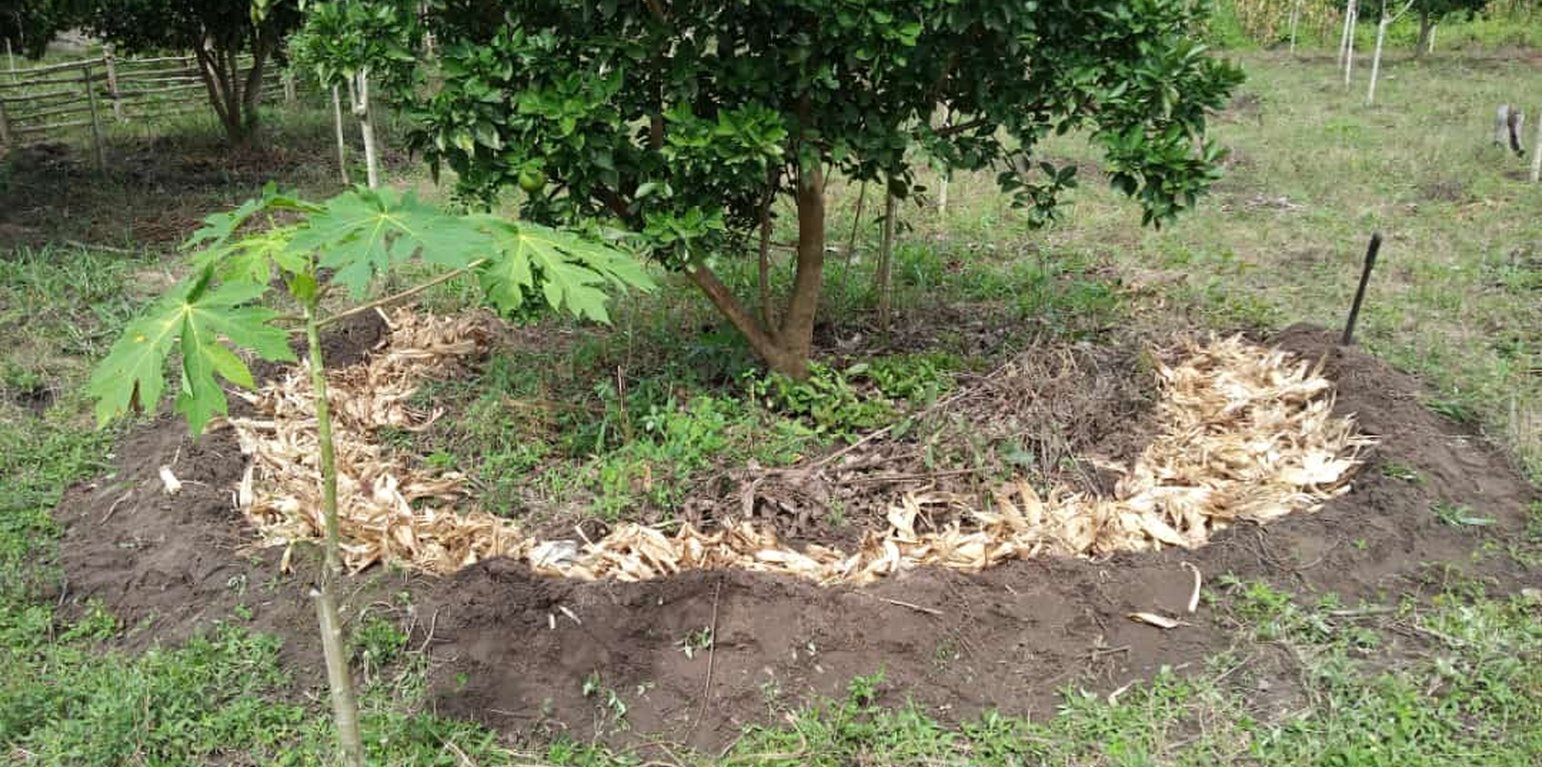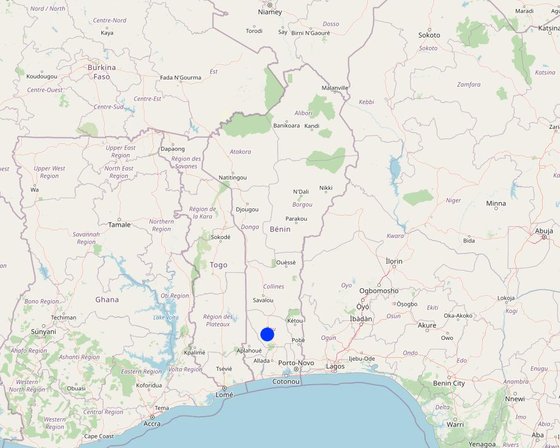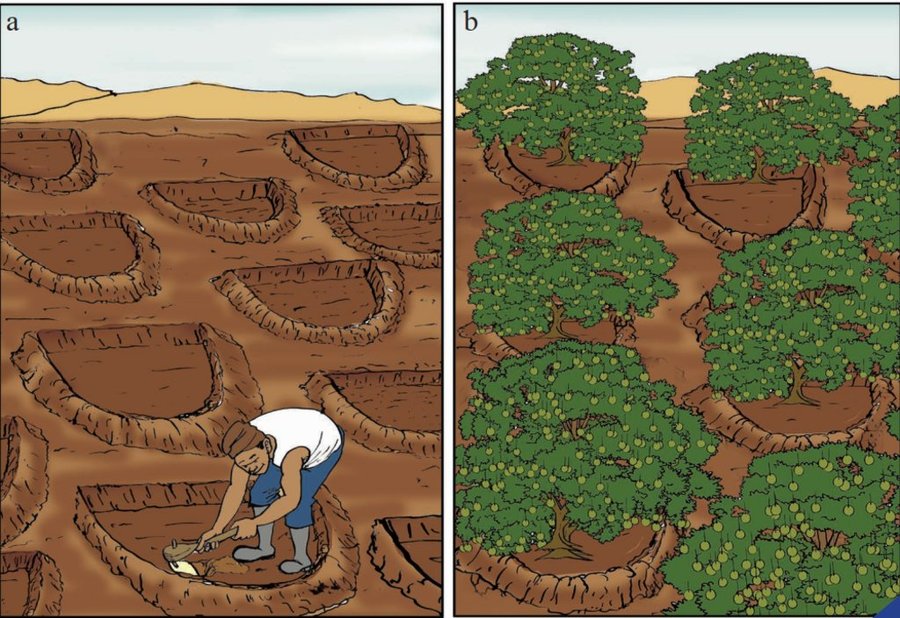



The half-moon technique is commonly used on sloping land in arid or semi-arid climates, especially for fruit plantations such as cashew and orange trees. It involves clearing the ground to create basin-like structures, which are a few meters in diameter and bordered by ridges. This technique is essentially used to (i) cultivate encrusted land, (ii) reduce runoff, (iii) concentrate rainwater at the foot of trees by improving its infiltration into the soil, (iv) induce early flowering of fruit trees, (v) improve fruit tree production and (vi) restore biological diversity to agroecosystems.
The protocol for installing the technique is as follows :
-Use a compass with a 2-meter radius to pivot and create the half-moon shape;
-Use a pick, pickaxe, and shovel to dig the half-moon to a depth of 15 to 20 cm;
-Build the ridges starting from the inside and working outward. The height of the ridges can vary, depending on the slope severity, but can reach up to 40 cm;
-Arrange the half-moons in a staggered pattern perpendicular to the slope or following the contour lines; and
-Maintain a 4-metre spacing between two rows of half-moons.
It is recommended to enrich the half-moons with organic fertilizer or well-decomposed compost. Depending on availability, up to 35 kg of compost or manure, or a wheelbarrow full, could be added to each half-moon. Once the half-moon has been installed, it is recommended that it be systematically mulched to minimize moisture loss.
The half-moon technique can be implemented at any time of the year, but preferably in February-March or August-September on orange and cashew trees, to maintain structures designed to collect runoff water. To ensure the longevity of the technique, it is advisable to reshape larger ridges whenever their size diminishes, to strengthen the barrier.

Location: Bohicon, Benin
No. of Technology sites analysed: 2-10 sites
Spread of the Technology: evenly spread over an area (2.0 km²)
In a permanently protected area?: No
Date of implementation: 2020
Type of introduction





| Specify input | Unit | Quantity | Costs per Unit (CFA F) | Total costs per input (CFA F) | % of costs borne by land users |
| Labour | |||||
| Sourcing the straw | Half moon | 625.0 | 50.0 | 31250.0 | 100.0 |
| Demarcation of the semi-circles | Half moon | 625.0 | 50.0 | 31250.0 | 100.0 |
| Digging to create ridges | Half moon | 625.0 | 100.0 | 62500.0 | 100.0 |
| Equipment | |||||
| Pickaxe or daba | Unit | 3500.0 | 1.0 | 3500.0 | 100.0 |
| Construction material | |||||
| Straw | Half moon | 625.0 | 50.0 | 31250.0 | 100.0 |
| Compost | Half moon | 625.0 | 1000.0 | 625000.0 | 99.0 |
| Total costs for establishment of the Technology | 784'750.0 | ||||
| Total costs for establishment of the Technology in USD | 1'275.64 | ||||
| Specify input | Unit | Quantity | Costs per Unit (CFA F) | Total costs per input (CFA F) | % of costs borne by land users |
| Labour | |||||
| Maintenance/Weeding | Half moon | 625.0 | 25.0 | 15625.0 | 100.0 |
| Mulching | Half moon | 625.0 | 25.0 | 15625.0 | 100.0 |
| Filling in collapsed areas (due to water) | Half moon | 625.0 | 50.0 | 31250.0 | 100.0 |
| Fertilizers and biocides | |||||
| Addition of manure or compost | Half moon | 625.0 | 100.0 | 62500.0 | 100.0 |
| Total costs for maintenance of the Technology | 125'000.0 | ||||
| Total costs for maintenance of the Technology in USD | 203.19 | ||||
Applied to citrus fruits (orange trees), the technology has resulted in a doubling of seedling production.
Half-moons are costly to create but beneficial in terms of results.
Half-moon application is labor-intensive.
Improved income means better access to health services.